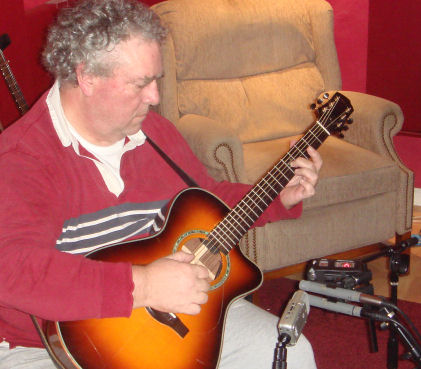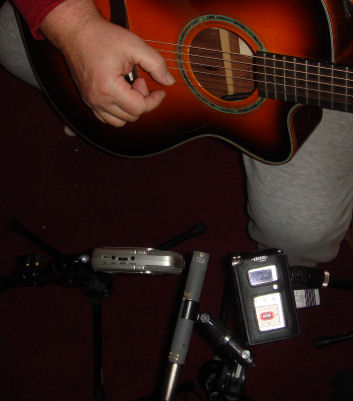When I read about preamps at various internet forums and newsgroups, I get the impression that microphone preamplifiers are a significant variable in the recording chain. And yet, when I’ve compared preamps, I don’t notice that much difference. Well, I do notice a difference if I crank the gain all the way up. Less expensive preamps tend do be noisy in their upper gain ranges. If I’m using my old faithful Beyer M260 ribbon mics, I need all the clean gain I can get from my John Hardy M1 mic pre. But if I am using a condenser mic with plenty of output, the mic pre is operating in the middle of its range, and I don’t hear much difference between a decent $150 unit and a decent $1500 one.
Now I know that preamps are used as effects, either blatant or subtle. The blatant ones are inexpensive units with a starved plate tube glowing prominently through some grillwork and a “drive” control to mix distortion generated by this tube into the signal. The more subtle ones often refer to various recording consoles as their inspiration, claiming Neve-like or API-ish qualities. I’ve never experimented with units like these. There may be huge differences between preamps when they’re used on vocals, drumsets, electric guitar amps, or exotic percussion, I just wouldn’t know. My focus is always on simple solo fingerpicked acoustic guitar recordings, where accuracy and clarity are my goal.
Many preamps aim to be accurate. The classic description of an accurate preamp is “a straight wire with gain,” an impossible achievement but an easy ideal to visualize. Product literature and user comments include terms like detailed, musical, natural, transparent. Inferior versions of these accurate preamps are described in internet forums as flat, boring, or two dimensional. Since I have a few preamps around these days I decided to try to do some comparison tests. As always with comparisons like this, the source material is a key issue. I decided to try to run one microphone through all three preamps at once, so the input signals would be the same. Making this connection is fraught with problems. If I connect the mic directly to the three inputs, the input impedance seen by the mic will be quite low, and may affect the mic response. If I use a transformer splitter or active buffer/splitter, the sonic signature of the splitter will be stamped on all the samples. My decision was easy, though, because I already have a box that lets me rig up a passive connection direct to the three inputs. If the mic response is affected, I’ll assume (until I’m shown otherwise) that the response is still the same for each preamp.
The key to this setup is a Coleman Audio LS3 switch box. I normally use this box to select between my headphone amp and monitor amp, but since it’s a completely passive box it works to route inputs or outputs equally well.
The three preamps under evaluation are the John Hardy M-1 as mentioned earlier, along with an FMR RNP and an M-Audio DMP3.
For the first test, I selected an Audio Technica AT4041 small diameter condenser mic. I routed it through the Coleman LS3 to the left channel of each preamp, then connected the left output of each preamp to an input of my LynxTwo C. I matched the volumes rather roughly using pink noise generated by Adobe Audition 1.5 and the metering on the Lynx software mixer. I set up a multitrack session in AA 1.5 to record three mono tracks from the three preamps. I positioned the AT4041 about 12″ from the 12th fret of an Epiphone Masterbilt EF-500M tuned to “drop C” tuning – CGDGBD low to high, and played a brief bit of noodling. After I listened to the tracks I realized I had not matched the levels well enough, so I normalized all the tracks to -3db. Here are the three sample tracks, mono 44.1/16 wave files:
Sample 1
Sample 2
Sample 3
Finally, I thought I would include a comparison with a dynamic mic as the source. It would require more gain from the preamps, and might be useful to folks who only have handheld dynamic stage mics in their collection. This time I used an Electrovoice RE16, connected as before. Again I set levels using pink noise and the Lynx software mixer, then recorded in a multitrack AA 1.5 session. This time the level matching was more accurate, so I didn’t feel the need to adjust the levels after recording. Naturally the performance is different from the first recording, AND THE ORDER OF PREAMPS IS DIFFERENT:
Sample 4
Sample 5
Sample 6
I hope you’ll download these and give a listen. Does one track in each set stand out from the others? Is one more transparent, another lifeless? Can you tell them apart? Perhaps you’d like to know which sample was created by which preamp? Click here for the key to relate the samples to the preamps used to create them.
PS – After I posted these, and after I sold my FMR RNP, people pointed out that the DMP3 samples were high-passed – that is, the DMP3 LoCut switch was activated, causing a shelving rolloff -3db at 72hz, 18db per octave. This may affect the comparison for some listeners and some playback systems.

